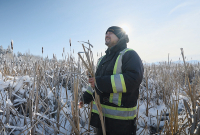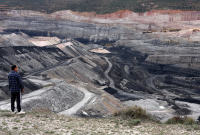Support strong Canadian climate journalism for 2025
A new scientific endeavour has taken to the sky using high-tech drones and satellite images to understand better the annual spring herring spawn vital to salmon and wildlife on the West Coast.
Between February and March each year, frigid ocean waters transform to a milky tropical-looking turquoise green when male herring release milt to fertilize the countless eggs deposited by females on eelgrass, kelp and seaweed fringing coastal shores.
Unpredictable and dramatic, the small silver fishes’ spawning event is large and best monitored from great heights, said Loïc Dallaire, a researcher with the SPECTRAL Remote Sensing Laboratory at the University of Victoria.
“It’s one of the very few animal formations that we can see from space, excluding human developments and towns,” Dallaire said.
“The idea behind remote sensing (technology) is to be able to monitor huge areas while spending less money than big field expeditions that are very, very expensive.”
Dallaire has been sprinting to areas on the east and west coasts of Vancouver Island to obtain drone footage and scientific samples at spawning events over the past couple of weeks.
His work will help puzzle out how and why spawning distribution has changed and declined over time as part of a broader study on herring and their habitat being conducted by the Pacific Salmon Foundation (PSF) until 2026.
The research project in partnership with coastal First Nations First Nations communities, will tackle key knowledge gaps around herring ecology and the importance of their role in the Strait of Georgia, particularly for salmon, said Jess Qualley, project manager for the PSF study.
Herring are a small forage fish with a huge role in the marine food web and are important not only for juvenile and adult salmon but a host of animals such as whales, sea lions, eagles and seabirds, Qualley said.
The PSF study will also examine how changes to herring spawning events might impact the availability of those baby fish as a food source for juvenile salmon, Qualley said.
Another line of research involving Qualley’s scientific work is aimed at learning more about non-migratory or resident herring populations that live in the Georgia Strait year-round and their importance in the food web under stress from climate change and other pressures.
The project will also provide funding for coastal First Nations to host events to share and celebrate traditional ecological knowledge on the past abundance of herring and how it influenced the traditions, distribution and settlement in the region.
Herring populations once plentiful stretching along the B.C. coast disappeared in the southern area of the Salish Sea following colonial industry and development in the Lower Mainland.
Overfishing led to a near collapse of other herring populations along the coast in the 1960s, followed by a short recovery period and a subsequent and ongoing decline in herring stocks starting in the 1990s. This has led to the closure of commercial fisheries on the Central Coast, west Vancouver Island and Haida Gwaii.
The only remaining region with an extensive commercial herring fishery is in the Strait of Georgia off the coast of central Vancouver Island, stretching roughly from Nanaimo in the south to waters north of Comox.

It’s not yet clear what specific factors prevent herring populations from bouncing back in each region on the coast, Qualley noted.
In addition to fishing pressures, the cumulative effects of climate change — warmer, acidic, less oxygenated oceans, shifting food sources, and more extreme weather in tidal zones — coupled with the loss of key habitat to human development and water quality concerns from urban and wastewater runoff may be impacting herring, research suggests.
In some instances, herring may adapt or benefit from changes in the marine ecosystem, said Dallaire. While critical eelgrass beds are in decline in some regions, herring seem to be taking advantage of an invasive seaweed called Japanese sargassum as a new place to deposit eggs, he said.
To fill in the gaps in knowledge about how herring spawns have changed over decades, Dallaire plans to analyze archives of coastal satellite images back to the 1980s along with historical data from Fisheries and Oceans Canada (DFO).
Aircraft surveys by DFO tend to focus on spawning events in core commercial fishing areas, Dallaire noted.
However, satellite images can likely detect and track smaller or more transitory spawning events along B.C.’s lengthy coastline that could be overlooked but are important to First Nations eager to document herring activity in their territories.
In addition to looking at herring's role in salmon food webs, the PSF project will help tease out what causes variability in the distribution of spawning events, Qualley said.
“Why do some herring select certain habitats and not others? That's one unknown question,” she said, noting spawning can sometimes be unpredictable and surprising.

This year, much of the herring spawn in the central Georgia Strait bucked a years-long trend and surfaced further south near the Qualicum area after having largely taken place in waters near Comox and Hornby and Denman islands.
The waters off Cortes Island, which typically see infrequent spawning events, were a hive of activity this spring, said biologist Sabina Leader Mense, marine stewardship co-ordinator for the Friends of Cortes Island Society (FOCI).
A significant spawning took place off the southern tip of the island on March 6, followed by a set of strong storms that churned up masses of eggs laid on seaweed and tossed them inches deep onto surrounding beaches.
Surveys will likely take place to try to determine the degree of damage to spawning and eggs in the island's tidal zone, Mense said.
Naturalist and Cortes Radio broadcaster George Sirk said it was the heaviest herring spawn he’d seen in the 50 years he’s been living on the island and seabirds turned out en masse for the feast.

Dallaire agreed the herring spawn is a natural spectacle that sparks a frenzy of activity among humans and wildlife alike.
Witnessing the event live when doing field work and collecting samples to confirm what’s happening on the ground with the information from satellite and drone images is a big thrill.
“Fish are jumping out of the water as sea lions were coming from below and seagulls were coming from above,” he said.
As many as 30 commercial fishing boats circled the coloured waters off Qualicum, while people gathered along the beach to watch or throw nets into the shallows for herring, he said.
“It was very, very impressive to see all this happening in the same place at the same moment. It's kind of the kickoff to summer.
“It’s a real party.”
Rochelle Baker / Local Journalism Initiative / Canada’s National Observer
This article was updated to note that funding will be provided for coastal First Nations community events to share traditional knowledge on the importance of herring. However, that information won't be a source of data for the research project.






Comments